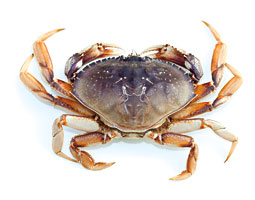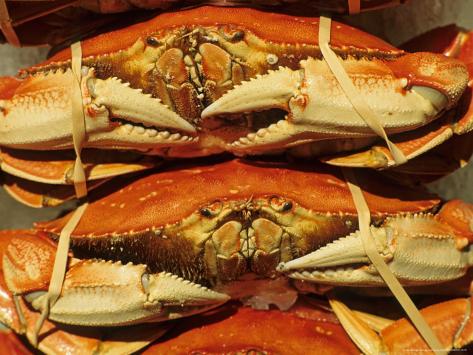天下美味 舌尖美食
天下美味 舌尖美食
今年蟹丰收 北美食蟹正当时 组图


Dungeness crab
by Hannelore Sudermann | © Washington State University
A few weeks ago, Brian Toste ’99 and his three-man crew set out from Westport, in southwest Washington, in Toste’s 45-foot vessel Huntress in search of Dungeness crab. They spent the first few days tying line and setting out some 500 crab traps, circles of metal and wire about the size and shape of large truck tires.
A few days later, when the traps were full, they returned to their buoys and pulled them out of the water. The crew quickly empties them by hand, says Toste. They toss the females and the male crabs smaller than 6-¼ inches across the back into the water, replenish the bait (usually squid and dead fish), and drop the pot back in before zooming off to the next one.
For the first three to four weeks of the season, the trap is full with up to 20 wriggling brown crabs. Males of the right size are dropped into a live storage tank.
All this is done pretty much regardless of the weather or the waves. “You have to keep track of the tide and the times, you have to take advantage of the weather windows,” says Toste. The peak of the Dungeness crab harvest is January and February, right smack in the middle of winter storm season. Toste and his crew are often out in 30-foot swells retrieving and emptying their pots.
“It’s extremely miserable out there,” says Toste. It helps if you are aggressive and physical. “When you’re in the crab, the work’s easy.” It’s a race to tend all 500 pots in a day. Washington fishermen set pots anywhere between 12 feet and 200 feet below the surface, says Toste. He typically fishes up to 60 feet deep.
In Washington, the commercial fishing season usually opens in early December in an area 13 miles north of the Columbia River and south and a month later along the Olympic Peninsula. The tribal fishery starts earlier. While just 238 commercial fishermen are licensed along with 30 tribal fishermen to hunt for crab along Washington’s coast, there are tens of thousands of pots out there. “It’s extremely crowded,” says Toste. In some places at peak season, “we don’t have the width of a pickup between one string and another.”
“It’s like a gold rush,” says Steve Harbell, the WSU/UW Marine Fisheries coordinator. “A lot of crab is harvested in the first couple of weeks.” The season continues through the summer. But as the days grow longer, fewer and fewer crabs show up in the pots. Toste catches 85 percent of his crab in the first month, and he readies for the end of harvest somewhere in late summer after he starts pulling up empties.
While the crab is named for Dungeness Bay, an inlet along the Strait of Juan de Fuca near Port Angeles, its habitat includes the Puget Sound and the Pacific Ocean Shelf, which runs from Alaska down to Santa Barbara, California. From the intertidal shore out to 300 feet deep, the crabs cover the floor by the millions, crawling across it on their sideways hunt for food.
The commercial harvest can only open if the crabs are ready, says Brian’s dad, Ray Toste, head of the Washington Dungeness Crab Fisherman’s Association. “We do seasonal testing,” he says. Following a certain protocol, crab managers check for toxins and to see if the crab is in optimal condition, mature with strong shells and plenty of meat.
“Crustaceans are kind of like insects, they have to shed their shells to grow,” says Harbell. The crabs you find at the market or store are likely four years old and may have shed their shells 12 times to get to harvestable size. “I say to kids, ‘How would you like to grow in the same clothes you have on?’”
Before and after molting, the crab develops its new shell. While the shell is still soft, the crab inflates it slightly with water, to make it a little bigger to grow into. Before and after the molt the meat isn’t the best quality, says Harbell. “And when you handle them with a soft shell, you can kill them pretty easily.” The major molt typically takes place in the late summer and early fall. During that time, crab fishing season is closed.
Even though they’re taking around 90 percent of the harvestable crab, by throwing back the females and the smaller males, the fishermen have been able to keep the Washington Dungeness stocks high, says Harbell. “Many years ago, we thought we were on a seven year cycle with peak years every seven,” says Harbell. But the last 20 years have changed that thinking. “The record catch for Washington was about 21 million pounds, and we’ve been in about 12 million, which is a good harvest, for the past three years.”
When the crabs are mature and the shell sufficiently hard, their meat yield is about 25 percent of their weight, one of the highest yield ratios of any food crab, says Harbell. If you don’t catch your own crab, he has this advice. “First it depends on what you’re going to do with it.” Some people like to serve crab in the shell, he notes. But for just the meat, you simply need to do the math. Remember that 25 percent meat yield. “If it’s $5 for the meat, versus $20 for the whole crab, you’re paying the same price, and you don’t have to do the work.”
Nonetheless, crabs are not so hard to clean, says Harbell. “All of us amateurs can shake a crab in five minutes,” he says. It takes a pro about a minute. The task of cleaning a cooked crab involves removing the back and flipping it over and pulling off the shell covering the abdomen. Then you pull off the visceral organs. A brown matter, called crab butter, will be present. Harbell likes to eat it with the crab, but most people wash it off. Then the body can be broken in half and the legs with attached body meat can be snapped off one at a time.
Dungeness is not like blue crab, which requires an intensive picking and cleaning, says Harbell. With the Dungeness, the sweet and delicate meat slides right out.
Jim Haguewood ’81, former director of the Clallam County Economic Development Council, has been eating and cleaning crab for as long as he can remember. His family owned the Haguewoods Restaurant in Port Angeles for 58 years. After graduating in hotel and restaurant management, he came home and ran the local landmark until 1998. Since then he’s turned his efforts toward economic development, but food isn’t far behind. “When you’re helping a community develop its economy, you look at what it has that’s truly unique,” says Haguewood. “For us, one of those things is Dungeness crab. We have the name and we have the crab.”
In 2002, the Port Angeles community kicked off its first Dungeness Crab and Seafood Festival. With the seafood, a growing local wine industry, and a burgeoning year-round fresh-produce business, the town couldn’t ignore its food assets. “With the festival, restaurants create their own unique menu items and they’re paired with wine,” says Haguewood. Crab cakes, crab rolls, crab dip, crab rangoon, crab Louis, crab cocktail, crab quesadillas, and crab bisque are just some of the offerings. Still, Haguewood’s favorite way to eat Dungeness crab is the simplest—cooked in salted water and then chilled.
Locally, there are several ways to obtain crabs, he says. One is to boat out on the water and put down a crab trap. You go back at least half a day later and retrieve it. The second is to fish off a pier using a ring net with a box of bait inside. And the third requires less equipment. On certain low tides, anyone with hip waders, a sack, and a rake can walk out at night with a flashlight and spot the crabs just under the water and pick them up. “It’s quite a social event,” says Haguewood. To do any of these, you must obtain a state crab fishing license and complete a catch record card.
You can also go out and look for a commercial fisherman selling crabs off his boat, says Toste. While he sells much of his catch to a processor, Toste will also sell to the live market and to locals who seek him out at the dock.
Toste grew up with his dad and brothers out fishing. He went to WSU and studied education and later found work in the Seattle area. But eventually he found his way back to Westport and on to a fishing vessel. In 2005, he bought his own boat, and in the past few years found a great crew, the key pieces to a successful crab fishing business. “I had to come back,” says Toste. “It’s in my blood.

Dungeness Crab at Pike Place Public Market, Seattle, Washington State, USA

Dungeness Crab, Pike's Place Market, Seattle, Washington, USA
北美的肥蟹——太平洋珍宝蟹 Pacific Dungeness Crab








维基百科,自由的百科全书
生物分类
邓金斯螃蟹
DungenessCrab.jpg

科学分类
界: 动物界 Animalia
门: 节肢动物门 Arthropoda
纲: 软甲纲 Malacostraca
目: 十足目 Decapoda
下目: 短尾下目 Brachyura
总科: 黄道蟹总科 Cancroidea
科: 黄道蟹科 Cancridae
属: 黄道蟹属 Cancer
种: 首长黄道蟹 C. magister
二名法
Cancer magister
Dana, 1852
首长黄道蟹(Cancer magister),又名邓杰内斯蟹、邓金斯螃蟹、唐金蟹、黄金蟹或邓津蟹[1](Dungeness Crab),是黄道蟹科黄道蟹属的一个蟹种,通常栖息于从阿拉斯加的阿留申群岛到美国加州的圣塔克鲁兹(Santa Cruz)漫草丛生的海床及水底[2],可食用,是北美洲西海岸盛产的一种食用蟹[1]。
这种蟹得名于美国华盛顿州的老镇邓杰内斯[2],位于史魁恩以北8公里,安吉利斯港以东25公里。

头部特写
蟹壳背部呈淡红至棕色,有些前面有紫色斑 点,下腹为白色至淡橘色,蟹钳为白色,最后尾节尖端呈圆形。大部分的重量为680克至1.4公斤。Cancer gracilis 大概是唯一容易和首长黄道蟹搞混的种类,两者的螯端皆为白色。不过,首长黄道蟹的螯是明显的锯齿状;C. gracilis的螯则较平滑。另外,首长黄道蟹步足的末三节有毛,C. gracilis 则无毛。
生态
在华盛顿州附近海域,邓杰内斯蟹的直径可达25厘米,但通常直径小于20厘米。日常在市场上可以买得到的蟹,最小的也有两磅重[1]。由于蟹的蟹甲宽而坚硬,邓杰内斯蟹在第一年需更换6次蟹甲,第二年需再更换6次蟹甲才能达到性成熟。它的主要食物包括蚌类、小型甲壳类动物和小鱼,但它也可以腐食为生;食物短缺时,也会出现同类相食的现象。天敌包括章鱼、大型鱼类、海獭和人类。在受到天敌威胁时,它可完全藏于沙中。
在交配季节,雄蟹受到雌蟹尿液中的信息素吸引而寻找雌蟹。雌雄蟹在交配前会拥抱数天。雌蟹在交配的数月以后产卵,雌蟹在交配后可携带 50 ~ 200万颗卵。这些卵会附着在雌蟹的腹部三到五月,直至孵化。新生的小蟹即会游泳。在出生后的两年当中,小蟹要经历约十次蜕壳才能成为成年蟹。
商业捕蟹与保育
首长黄道蟹的蟹肉质鲜美,是东北太平洋沿岸重要的商业蟹类。单是加州中部 (旧金山、蒙特利地区) 的鱼场,一年平均便可捕获200万磅。
商业捕蟹仅限于尺寸6 ¼ 英寸 (15.9 厘米) 或更大的雄蟹。雌蟹需立即释放。这确保螃蟹一年至少有一次繁殖季。捕蟹季通常开始于12月1日,当蟹壳已经长硬,这表示壳内已经长好结实的肌肉。在捕捞季开始前会有测试,确定螃蟹平均至少有25% 的蟹肉含量。蟹肉含量一般由13 - 30%不等,取决于脱壳及繁殖时间和环境因素,如食物和海洋条件等。此蟹全年都可在加拿大海域捕获,尤以五月至十月为量产。
肉质细嫩、味道鲜美,带有淡淡坚果香味,身体部位肉质滑嫩,脚肉较为扎实,主要原因是黄金蟹可以不同方向的移动,而且必要时可以相当快速。可煎、 炸、蒸、煮,或与其他海鲜混合烹调。通常以活蟹方式运送至全球各地,也有以加工及新鲜现煮或去壳蟹肉方式贩售。
可持续海鲜评级机构Seafood Watch对于现时首长黄道蟹的保育给予了“最佳选择”('Best Choice')的评价[3]。
2009年,来自俄勒冈州西北部克拉克默斯县西林恩的日落小学学生的游说,基于首长黄道蟹对俄勒冈州经济的重要性,建议把首长黄道蟹订定为“州蟹”;议案于2009年尾通过[4]。
————————————
邓杰内斯蟹(英文名:Dungeness crab)得名于美国华盛顿州的老镇邓杰内斯。在华盛顿州附近海域,邓杰内斯蟹的直径可达25厘米,但通常直径小于20厘米。其拉丁语学名意为“大师蟹”。
邓杰内斯蟹得名于美国华盛顿州的老镇邓杰内斯。邓杰内斯蟹通常栖息于从阿拉斯加的阿流申群岛到美国加州的圣塔克鲁兹鳗草丛生的水底。其拉丁语学名意为“大师蟹”。
在华盛顿州附近海域,邓杰内斯蟹的直径可达25厘米,但通常直径小于20厘米。因为蟹甲宽而坚硬,邓杰内斯蟹需更换数次蟹甲才能长大。它的主要食物包括蚌类、小型甲壳类动物和小鱼,但它也可以腐食为生。在受到天敌威胁时,它可完全藏于沙中。
在交配季节,雄蟹受到雌蟹尿液中的信息素吸引而寻找雌蟹。雌雄蟹在交配前会拥抱数天。雌蟹在交配的数月以后产卵。这些卵会附着在雌蟹的腹部三到五月,直至孵化。新生的小蟹即会游泳。在出生后的两年当中,小蟹要经历约十次蜕壳才能成为成年蟹。
该蟹肉质鲜美,是西北太平洋沿岸重要的商业蟹类。
学名:Cancer magister
英文名:Dungeness crab

今年蟹丰收 饕客有口福
编译组╱综合4日电
November 05, 2013 09:25 AM

去年在旧金山附近海域捕到的邓金斯蟹。 (Getty Images)
湾区今年的邓金斯蟹季已开始。
「运动捕蟹」(sport fishing)2日开始,「商业捕蟹」则于15日开始;渔民和渔业专家都估计,湾区今年会有一个很好的蟹季,收获将会很不错。
不过,2日第一天的运动捕蟹情况并不理想。这种捕蟹只准每人每天捕捉十只蟹,且每蟹至少要长至5.75吋以上,未长成的蟹不能捕。捕蟹人在2日零时零1分开始放蟹笼下海,要到第二天才提起笼子。
鲁宾(Jim Rubin)在圣他克鲁兹县将笼子放在200呎的海底,原以为至少会捕到30只蟹,但只捕到8只。
不过,「湾畔渔讯」的希尔(Greg Hill)说,第一天的情况不理想,并不妨碍对今年收获的预测。
希尔说,去年渔民捕到很多细小的蟹,显示今年的收成会不错。
州渔猎局的科学家卡瓦斯(Pete Kalvass)也说,从历史看,今年的收获会很不错。
他说,去年的邓金斯蟹收获达110万磅,是1915年以来最多;2010和2011两年的收成也很好,可以看出,目前正是邓金斯蟹的高峰期,就算今年不比去年好,也不会大幅减少,至少会与去年差不多。
他指出,蟹产量与每年春天州渔猎局放进海里的邓金斯蟹幼虫有关,从今年情况看,幼虫的生存率很高,所以今年的收成会很不错。
邓金斯蟹是湾区附近海域的特产,因为这种蟹较喜欢北加州较冷的海水温度。从金门大桥对面的法拉农群岛海域到圣荷西以南的蒙特瑞湾都是蟹产地。渔民说,今年蟹价,估计每磅为3元至3.5元。
Read more: 世界新闻网-北美华文新闻、华商资讯- 今年蟹丰收 饕客有口福




